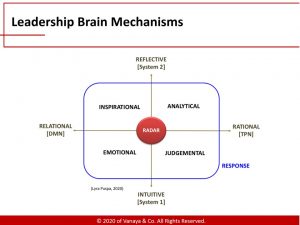
Margaret Armitage, 22nd April 2020
Amongst the flood of valuable online material, webinars, zoom meetings that make up life in COVID-19, there are one or two that have really resonated and bring a whole new awareness to me as a Leadership Coach (and a person, dare I say) in both an online world and when we return to ‘normal’.
The first that resonated was a revelation for me at a personal level regarding my own energy, or lack of! Many of us – me, my clients, colleagues and friends and family are feeling more exhausted being locked down, working from home, which is strange when you think about it because I for one expected to have so much more time and be more relaxed without travel (in the air or on the ground) to fit into my life, or to negotiate my time around grandchildren’s school runs, or an exercise class or a myriad of things.
Well, it isn’t as I expected!
The online environment is more demanding – this new intimacy significantly amplifies the need for those in leadership to be present and expand our awareness. In other words, we need to stay focussed, we cant doodle, check social media or let our minds wander and then plug back in. It is more demanding because we are “missing many of the environmental and personal visual cues which enable us to easily speak or present face-to-face”.
I learnt this in a post from Claire Braund, Executive Director of Women on Boards, “The ON-switch is never OFF in this new World of Work”
The message to take from this is that our brains are working in a different way which accounts for some of the exhaustion we are feeling and we need to develop extra muscles used to build intimacy and presence at the same time as we are managing other tasks, such as checking the ‘chats’ and questions in our zoom meeting , ‘admitting’ people to the meeting, helping out those who ‘can’t get on’ – all this whilst remaining fully engaged with the webinar we are running and of course – looking into the camera. It can be exhausting!!
The second amazing series of revelations came from an equally incredible woman, Lyra Puspa a neuroscientist and leadership coach who gave a webinar titled “Decoding the neuroscience of Leaders” or in my lay terms “How do Leaders Minds Work?”
The first significant fact that I discovered is that even when we aren’t using them our brain consumes around 20% of our energy! Which explains why this new world of work which demands much more brain activity is causing leaders to feel drained.
Another amazing insight from Lyra was the impact that stress and lack of sleep can have on our leadership brain’s mechanism. Now we all might know this intuitively and even have experience it, but Lyra explained why. The mechanism our brain follows when making decisions are almost involuntary – we have Fast, intuitive thinking 95% of the time and Slow, reflective thinking only 5% of the time. It is much easier to think Fast, like being on autopilot than it is to Slow down and be deliberate and intentional. When we are tired our default is Fast thinking – although we might feel like we are slow!
In addition to that we have two distinctly different Thinking Neural networks to inform our decision-making. The two networks cannot work at the same time – the DMN (Default Mode Network) manages the Relational thinking for feelings, empathy,other-centered information whilst the TPN (Task Positive Network ) manages Rational thinking, based on judgement, task, action and goal oriented neural activity.
Therefore, leaders cant work on a Financial Report and actively support the emotional needs of staff at the same time. It is impossible for our brains to do this. Switching from one network to another quickly and easily is what leadership is about. If we have had a bad night’s sleep or are stressed and anxious we will flip too quickly into Rational/Judgemental TPN thinking and may even show up as more racist or harsh in our decision-making.

Finally, leadership isn’t located in one part of the brain, however, there are two hormones, testosterone and cortisol, that influence our leadership style. These hormones are present in everyone but the aim is to have higher Testosterone levels to help us be inspiring, fearless leaders and lower Cortisol levels to keep us healthy. Cortisol, sometimes called the ‘stress’ hormone blocks testosterone and reduces our immune systems. Studies show that high performing leaders have high testosterone, are resilient, bounce-back easily and see stress and failure as just another event. Whilst low performing leaders have high cortisol and take failure very seriously. Lyra’s research showed that cortisol reduces when we are at peace and in a deep reflective state and testosterone lifts. Brain measurements showed that during facilitated leadership coaching leaders can move into a deeply reflective state that induces a mindful state, similar to deep meditation in Buddhist monks. Following this deeply reflective state, an ‘aha moment’ frequently occurs resulting in transformational change. As a leadership coach, I hope for that for all my clients.
So, it isn’t just an old wives tale that sleep and reflection builds strong leaders – It is proven by neuroscience that good rest, good food and mindfulness build up the muscles in our leaders brains helping us lead through difficult times. Please look after yourselves.







